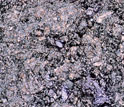|

Press Release 08-085
Hold the Old Lace: Arsenic and Iron Material Is a Remarkable Superconductor

New class of superconducting material could help reveal the mechanism of superconductivity at higher temperatures
May 27, 2008
It may not be what Cary Grant had in mind when he uncovered his elderly aunts' recipe for doing away with lonely bachelors in the classic film, "Arsenic and Old Lace." But superconductors discovered a few months ago by scientists in Japan are displaying remarkable properties that present real mysteries to materials scientists. The new class of materials that exhibit superconductivity at relatively high temperatures contain no copper-oxygen layers. Instead they have rather lace-like layers composed of arsenic and iron. A great flurry of activity to understand these new superconductors is underway. Researchers at the National High Magnetic Field Laboratory (NHMFL), a facility established by the National Science Foundation in 1990, are using high magnetic fields to probe the properties of these materials, hoping to unlock the secret of their superconductivity. Frank Hunte, a postdoctoral associate at the lab's Applied Superconductivity Center (ASC), working with David Larbalestier, Alex Gurevich, Jan Jaroszynski and colleagues in David Mandrus' group at Oak Ridge National Laboratory in Tennessee, discovered surprising magnetic properties in the new superconductors that suggest the materials may have very powerful applications--from improved MRI machines and research magnets to a new generation of superconducting electric motors, generators and power transmission lines. The research, detailed in the latest issue of the journal Nature, also adds to the long list of mysteries surrounding superconductivity. The researchers present evidence that the new materials, which scientists are calling "doped rare earth iron oxyarsenides," develop superconductivity in quite a new way. One of the most fascinating phenomena in nature, superconductivity can be thought of as "frictionless" electricity. In conventional electricity, heat is generated by friction as electrons (electric charge carriers) collide with atoms and impurities in a wire. This heating effect is good for appliances such as toasters or irons, but not so good for most other applications that use electricity. In some materials, a dramatic change takes place at very cold temperatures--electric current glides through the materials without dissipation. Powerful magnets that rely on this phenomenon of superconductivity enable Magnetic Resonance Imaging for medicine, and open new frontiers for scientific discovery at research centers such as the NHMFL. According to conventional wisdom, magnetic fields are to superconductivity as Kryptonite is to Superman--progressively higher magnetic fields weaken superconductivity until, at high enough magnetic fields, superconductivity is gone. Researchers at the NHMFL use powerful magnets to explore how the superconductivity in a new superconducting material is weakened by magnetic fields. They are finding that these new iron-arsenic materials are less susceptible to the "Kryptonite" of magnetic fields than conventional wisdom would have predicted. The discovery suggests that these iron-arsenic compounds enable an entirely new kind of superconductivity. Until the mid-1980s, all known superconductors exhibited superconductivity at temperatures below a frigid -440 degrees Fahrenheit (F), or about 2O degrees Kelvin. The discovery of the so-called "high temperature superconductors" pushed the upper temperature limit for superconductivity to a still frosty -200 degrees F. The secret of how high-temperature superconductivity arises in these materials revolves around electrons in layers composed of copper and oxygen atoms. Unlike the "low temperature superconductors" which are well described by the theory of superconductivity forged some 50 years ago by (John) Bardeen, (Leon Neil) Cooper and (John Robert) Schrieffer and polished into the standard theory of superconductivity by the work of many others, the mechanism of superconductivity in the high temperature superconductors remains a mystery. In the mid-1980s, the first materials that exhibited superconductivity at modest but comparatively high temperatures gave way to the refined materials of today with much higher transition temperatures. The discovery of the iron-arsenic materials, which exhibit superconductivity at high temperature but do not contain the signature copper-oxygen layers, could hold the key to understanding the phenomenon of superconductivity at elevated temperatures more generally. < p>Though research on this substance is very much in its early stages, scientists are talking excitedly of "promise" and "potential." If scientists and engineers ever harness this phenomenon at or near room temperature in a practical way, untold billions could be saved on energy costs. "What one would like is a greater selection of superconductors, operating at higher temperatures, being cheaper, possibly being more capable of being made into round wires," said Larbalestier, director of the ASC. "Iron and arsenic, both inherently cheap materials, are key constituents of this totally new class of superconductors. We're just fascinated. It's superconductivity in places you never thought of."
-NSF-

Media Contacts
Maria C. Zacharias, NSF (703) 292-8070 mzachari@nsf.gov
Susan Ray, National High Magnetic Field Laboratory (850) 644-9651 sray@magnet.fsu.edu
Program Contacts
Guebre X. Tessema, NSF (703) 292-4935 gtessema@nsf.gov

The National Science Foundation (NSF) is an independent federal agency that supports fundamental research and education across all fields of science and engineering. In fiscal year (FY) 2009, its budget is $9.5 billion, which includes $3.0 billion provided through the American Recovery and Reinvestment Act. NSF funds reach all 50 states through grants to over 1,900 universities and institutions. Each year, NSF receives about 44,400 competitive requests for funding, and makes over 11,500 new funding awards. NSF also awards over $400 million in professional and service contracts yearly.
 Get News Updates by Email Get News Updates by Email
Useful NSF Web Sites:
NSF Home Page: http://www.nsf.gov
NSF News: http://www.nsf.gov/news/
For the News Media: http://www.nsf.gov/news/newsroom.jsp
Science and Engineering Statistics: http://www.nsf.gov/statistics/
Awards Searches: http://www.nsf.gov/awardsearch/
| 



